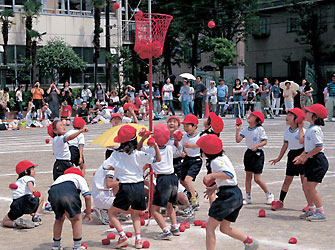 |
|
School track and field meets
For elementary school kids, track and field meets held at their schools every autumn are a big event. Students are divided into two teams: Aka-gumi ("The Reds") and Shiro-gumi ("The Whites"). Teams face off in a wide range of events, from sprints and relay races to tug-of-wars and tama-ire (a ball game, see photo above). Everyone is expected to train hard for several weeks, preparing for the big day when relatives come to cheer them on. Group gymnastics and dancing are just two of the other attractions. (Photo by Ishiyama Jun)
|
 |
|
Cuisine for autumn dining
There is lots of delicious food to eat in Japan when autumn comes, and that is the meaning behind the expression, shokuyoku no aki ("autumn, the season of hearty appetites"). A fish called samma (Pacific saury) is in prime condition during the fall, making it a delicious treat. The characters for samma are written "autumn-blade-fish, "implying that this fish is most delicious in autumn. (Above photo: Kadoyama Takashi, Haga Library) What is the tastiest and most sought-after autumn food of all? Matsutake mushrooms (lower right).
|
|
 |
October 1st to December 31st
Red Feather Community Chest Campaign
Members of the public are asked to donate to a community campaign raising funds for social welfare projects. On the first day of the campaign, students and other volunteers stand on busy streets, call out for donations, and give a red feather to each donor. |
| |
|
 |
7th to 9th
Nagasaki Kunchi Festival, at Suwa Shrine in Nagasaki, Nagasaki Prefecture
The festival has been designated an important intangible folk cultural asset. This stupendous carnival attracts tourists from all over Japan. Shrine parishioners participate in exotic performances that include a Chinese-style dragon dance called Ja Odori. |
| |
|
 |
9th and 10th
Aki no Takayama Festival, at Sakurayama Hachiman Shrine in Takayama, Gifu Prefecture |
| |
|
 |
9th to 11th
Kotohira Festival, at Kotohira Shrine, Kotohira-cho, Kagawa Prefecture |
| |
|
 |
Second Monday in October
Taiiku no Hi (Health Sports Day)
Events are organized to encourage sports activity and promote the ideal of a sound mind in a sound body. Designated a national holiday in 1966, to commemorate the opening day (October 10) of the 1964 Tokyo Summer Olympic Games, the first Olympics ever held in Asia. |
| |
|
 |
14th
Tetsudo no Hi (Railway Day) |
| |
|
 |
15th to 17th
Kanname Festival, at Ise Shrine, Ise, Mie Prefecture
Shinto priests offer newly harvested rice to the gods in a ceremony to thank them for the good crop. The most important Shinto ritual at this major shrine. Local people also dedicate heads of rice at the shrine, and perform the hatsu-ho hiki (first rice sampling) ceremony in thanks for nature's bounty. |
| |
|
 |
15th to 21st
Shimbun Shukan (Newspaper Week) |
| |
|
 |
Mid-October
The best teams in the professional baseball leagues compete in the Japan Series |
| |
|
| |
Formula 1 Japanese Grand Prix |
| |
|
| |
Jidai Festival of the Ages, at Heian Shrine, Kyoto, Kyoto Prefecture |
| |
|
 |
22nd
Kurama no Hi Fire Festival, at Yuki Shrine, Kyoto, Kyoto Prefecture |
| |
|
 |
October 27th to November 9th
Dokusho Shukan (Reading Week) |
| |
|
 |
29th
Kiba no Kakunori, in Koto-ku, Tokyo
Lumbermen perform acrobatic stunts on floating logs in Tokyo's Kiba district, where timber from all over Japan is marketed.
|
|




